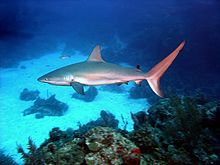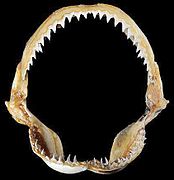Caribbean reef shark
| Caribbean reef shark | |
|---|---|

| |
| Scientific classification | |
| Domain: | Eukaryota |
| Kingdom: | Animalia |
| Phylum: | Chordata |
| Class: | Chondrichthyes |
| Subclass: | Elasmobranchii |
| Subdivision: | Selachimorpha |
| Order: | Carcharhiniformes |
| Family: | Carcharhinidae |
| Genus: | Carcharhinus |
| Species: | C. perezi
|
| Binomial name | |
| Carcharhinus perezi (Poey, 1876)
| |

| |
| Range of the Caribbean reef shark | |
| Synonyms | |
|
Eulamia springeri Bigelow & Schroeder, 1944 | |
The Caribbean reef shark (Carcharhinus perezi) is a species of requiem shark, belonging to the family Carcharhinidae. It is found in the tropical waters of the western Atlantic Ocean from Florida to Brazil, and is the most commonly encountered reef shark in the Caribbean Sea. With a robust, streamlined body typical of the requiem sharks, this species is difficult to tell apart from other large members of its family such as the dusky shark (C. obscurus) and the silky shark (C. falciformis). Distinguishing characteristics include dusky-colored fins without prominent markings, a short free rear tip on the second dorsal fin, and tooth shape and number.
Measuring up to 3 m (9.8 ft) long, the Caribbean reef shark is one of the largest
Taxonomy and phylogeny
The Caribbean reef shark was originally described as Platypodon perezi by
Based on
Distribution and habitat

The Caribbean reef shark occurs throughout the tropical western Atlantic Ocean, from North Carolina in the north to Brazil in the south, including Bermuda, the northern Gulf of Mexico, and the Caribbean Sea. However, it is extremely rare north of the Florida Keys. It prefers shallow waters on or around coral reefs, and is commonly found near the drop-offs at the reefs' outer edges.[4] This shark is most common in water shallower than 30 m (98 ft), but has been known to dive to 378 m (1,240 ft).[1]
Description

A heavy-bodied shark with a "typical" streamlined shape, the Caribbean reef shark is difficult to distinguish from other large requiem shark species. It usually measures 2–2.5 m (6.6–8.2 ft) long; the maximum recorded length is 3 m (9.8 ft) and the maximum reported weight is 70 kg (150 lb).
The snout is rather short, broad, and rounded, without prominent flaps of skin beside the nostrils. The eyes are large and circular, with
-
Jaws
-
Upper teeth
-
Lower teeth
Biology and ecology

Despite its abundance in certain areas, the Caribbean reef shark is one of the least-studied large requiem sharks. They are believed to play a major role in shaping Caribbean reef communities. These sharks are more active at night, with no evidence of seasonal changes in activity or migration. Juveniles tend to remain in a localized area throughout the year, while adults range over a wider area.[7]
Caribbean reef sharks are sometimes seen resting motionless on the sea floor or inside caves; it is the first active shark species in which such a behavior was reported. In 1975,
Juvenile Caribbean reef sharks are preyed upon by larger sharks such as the
Feeding

The Caribbean reef shark feeds on a wide variety of reef-dwelling
Life history
Reproduction is
Human interactions

Normally shy or indifferent to the presence of divers, the Caribbean reef shark has been known to become aggressive in the presence of food and grows sufficiently large to be considered potentially dangerous.[6] As of 2008, the International Shark Attack File lists 27 attacks attributable to this species, 4 of them unprovoked, and none fatal,[13] though a fatal attack on the island of St. Martin/St. Maarten in 2020 is being blamed on the species.[14]
This species is taken by
Shark feeding

A profitable ecotourism industry has arisen around this species involving organized "shark feeds", in which groups of reef sharks are attracted to divers using bait. Some US$6,000,000 is spent annually on shark viewing in the
Conservation
The
References
- ^ doi:10.2305/IUCN.UK.2021-1.RLTS.T60217A3093780.en. Retrieved 19 November 2021.)
{{cite journal}}: CS1 maint: multiple names: authors list (link - ^ ISBN 978-92-5-101384-7.
- S2CID 39697113.
- ^ a b c d e f g h i j k l Scharfer, A. Biological Profiles: Caribbean Reef Shark Archived 2012-07-24 at the Wayback Machine. Florida Museum of Natural History Ichthyology Department. Retrieved on February 14, 2009.
- ^ Froese, Rainer; Pauly, Daniel (eds.) (2009). "Carcharhinus perezii" in FishBase. February 2009 version.
- ^ ISBN 978-1-55209-629-1.
- S2CID 85922851.
- ^ a b c d e f Martin, R.A. Caribbean Reef Shark. ReefQuest Centre for Shark Research. Retrieved on February 14, 2009.
- .
- S2CID 86183700.
- ^ S2CID 55404266.
- .
- ^ ISAF Statistics on Attacking Species of Shark. International Shark Attack File, Florida Museum of Natural History, University of Florida. Retrieved on April 22, 2009.
- ^ {[1]
- ISBN 978-2-8317-0650-4.
- ^ Murch, A. Shark Feeding. Elasmodiver.com. Retrieved on February 14, 2009
External links
- Photos of Caribbean reef shark on Sealife Collection




